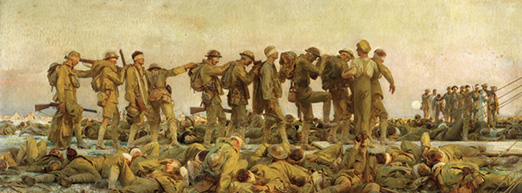Chapter 3
World War: Choices and Consequences
Overview
The ways societies define “we” and “they” can help to precipitate war. In turn, the violence and chaos of war can sharpen the differences people perceive between their nation and others, as well as between different groups within their own nation. This chapter focuses on how World War I shaped and was shaped by ideas of “we” and “they,” and it highlights aspects of the war that influenced the history of Nazi Germany in the following decades.

© IWM (Art.IWM ART 1460)
Essential Questions
- How did World War I change the balance of power in Europe? How did it affect people’s attitudes toward other nations as well as their own? How did it affect people’s attitudes toward war?
- How did World War I affect the way that people perceived the value of human life?
- What happens to the way a society defines “we” and “they” in the midst of the chaos and violence caused by war?
Introduction
The world war that began in 1914 in Europe would eventually involve 30 nations and 65 million soldiers. It was a war with incredible loss of human life on every battlefront and huge damage to the land wherever fighting occurred; it was marked by genocide, civil wars, famines, and revolutions. World War I was a total war, affecting thousands of civilians even in countries where no actual fighting took place. By its end, more than 9 million soldiers and more than 5 million civilians were killed. As a result of the war, three European empires fell. But the war had encouraged strong nationalist feelings in the countries that had made up those fallen empires, creating lingering post-war tensions, not only in Europe but also in the colonies in Asia and Africa, where pre-war racism continued to endure.
World War I, which many had hoped would be the “war to end all wars,” was an explosion of violence on a scale never before seen in modern history. That explosion, wrote philosopher Hannah Arendt in 1951, “seems to have touched off a chain reaction in which we have been caught ever since and which nobody seems to be able to stop.”1 And yet neither the First World War nor the Second, which began 25 years later, was inevitable. Each was the result of decisions made by individuals and groups.
Chapter 3 focuses on the explosion of violence Arendt describes and the chain reaction it set off. This chapter begins the case study of the years leading to the Holocaust, which is the centerpiece of the Facing History and Ourselves journey. But instead of tracing the course of the war itself, the chapter highlights the aspects of World War I that had an important effect on the history of Nazi Germany and the Holocaust. Historian Doris Bergen writes that while World War I did not cause Nazism or the Holocaust, its aftermath left in place fertile ground for the history that followed in at least three ways. First, the destruction and brutality of World War I “seemed to many Europeans to prove that human life was cheap and expendable.” Second, the trauma of World War I created in Europeans and their leaders a “deep fear of ever risking another war.” Third, the war’s resolution left in place across Europe lingering resentments about the war and the terms of the peace. These resentments would later prove useful to leaders such as Adolf Hitler who sought to create “a politics of resentment that promoted a bitter sense of humiliation.”2 As teachers and their students explore the history of World War I, they should select the readings from this chapter that are most appropriate for their curriculum and classrooms.